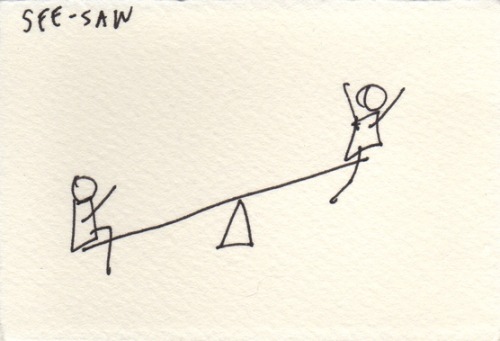
How much meaning can you find in a hot dog cart? Or a trapeze artist? Or a satellite?
Well, I mean, actually, a lot of meaning can be found in satellites, what with making global communications possible/crashing down in the South Pacific, so ignore the nonrhetorical nature of that last part.

But anyway, there's meaning to be found in things that don't help you find Green Bay/serve as orbiting headquarters for the Justice League, and Fastest Possible Drawings Of Everything finds those meanings via -- as the name doesn't just imply but flat-out says -- drawing things quickly.
Things like:



There's no time posted on that last one, which I think is the first-ever fastest possible drawing there, and which is one of the only drawings on this blog that doesn't have an explanation, an explanation that somehow manages to be both ridiculous and sublime -- subdiculous? riblime? Ridiculime?
I'll go with that latter, as you correctly guessed if you read the post title and remembered it this far into the post.
To get a feel for what the site is really like, here's the entire post for See Saw:

A See-Saw, in 8 seconds.
If you have graduated from elementary school, you have probably learned (and perhaps forgotten) about the six simple machines, of which my favorite is the Lever. The lever takes any boring rigid object (say, a board) and, by placing a compact hunk of material—the fulcrum—somewhere underneath it, creates a magical easy-lifting device! In pictures, the fulcrum is almost universally drawn as a triangle:
You will note that this picture is shockingly similar to the Fastest Possible See-Saw, whose implementation of the Lever is perhaps the most entertaining to children. In fact, the see-saw is an easily-recognized implementation of the “First Class Lever”, whose fulcrum is placed between the effort (red rectangle, above) and the load (green fella, above), and which is conveniently illustrated as follows:
Um, hello! The Fastest Possible See-Saw, as drawn by David here, is actually also the Fastest Possible Drawing of a First-Class Lever (double win)!
Now, look closely at the simple machine these kids are playing on. I can’t say why the girl in this picture has taken the enormous personal risk of riding in front of the handle, as we all know what happens when the kid on the left (the “effort”) decides to jump off (the “jerk”). She is in great danger, as is the “load” in our Fastest Possible See-Saw, whose hands are raised triumphantly (and dangerously) in the air. That sense of danger characterizes the classic see-saw experience—and why, America, do we tolerate that?
Because, friend, as far as we are concerned, the Fastest Possible See-Saw is an instrument not just of physics, but also of trust. A picture of a triangle and a line could make a see-saw, but you need the two kids to complete the drawing. Without them, it’s just a drawing of a First Class Lever, but the kids make the trust, and the trust makes the see-saw. Actually, it’s a sad thing that you can’t find these things around much anymore, as they were the best part of the playground, and I’m guessing society has gradually come to value safety over trust when it comes to kids and how they play. Game consoles or simple machines? Think on that.
Also, how weird is the word “see-saw”? Right?
Fastest Possible See-Saw, and a lesson in trust. Eight Seconds.
See what I mean? Greatest thing in the world ever. Read it here.


2 comments:
Here and I thought somewhere in all of this there'd be the fastest possible pair of boobs ever.
That post was ridonkulous!
Ha ha, the word verification is "palin"; this comment sponsored by the Tea Party.
Post a Comment